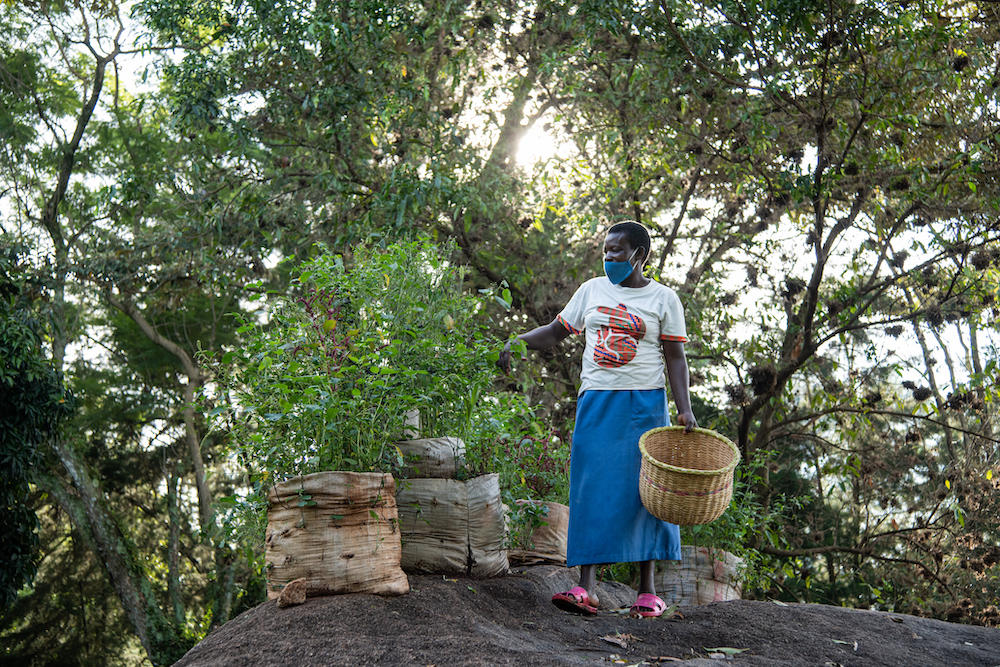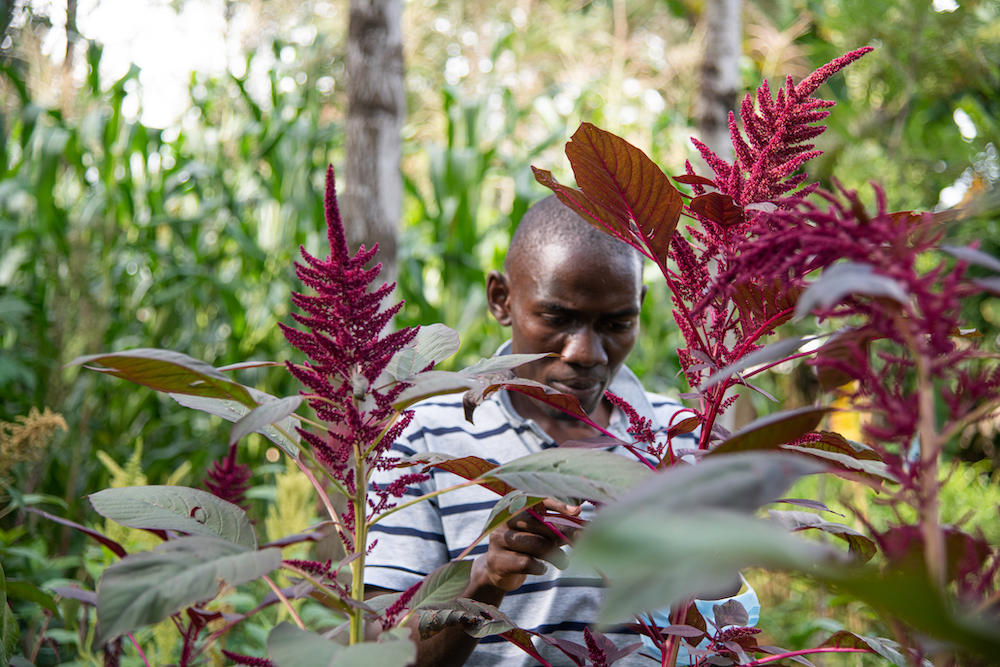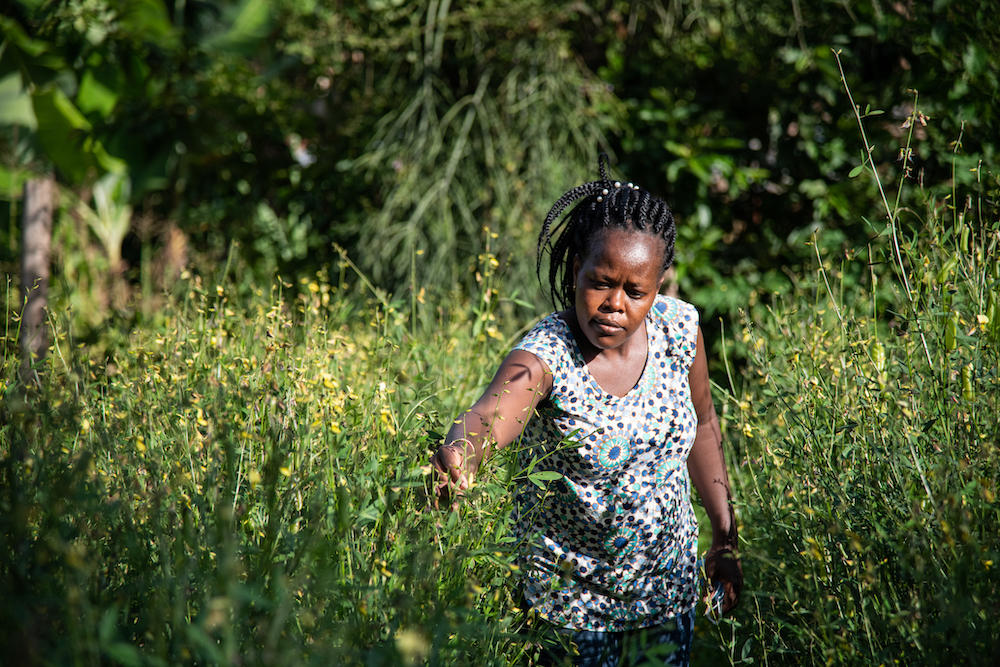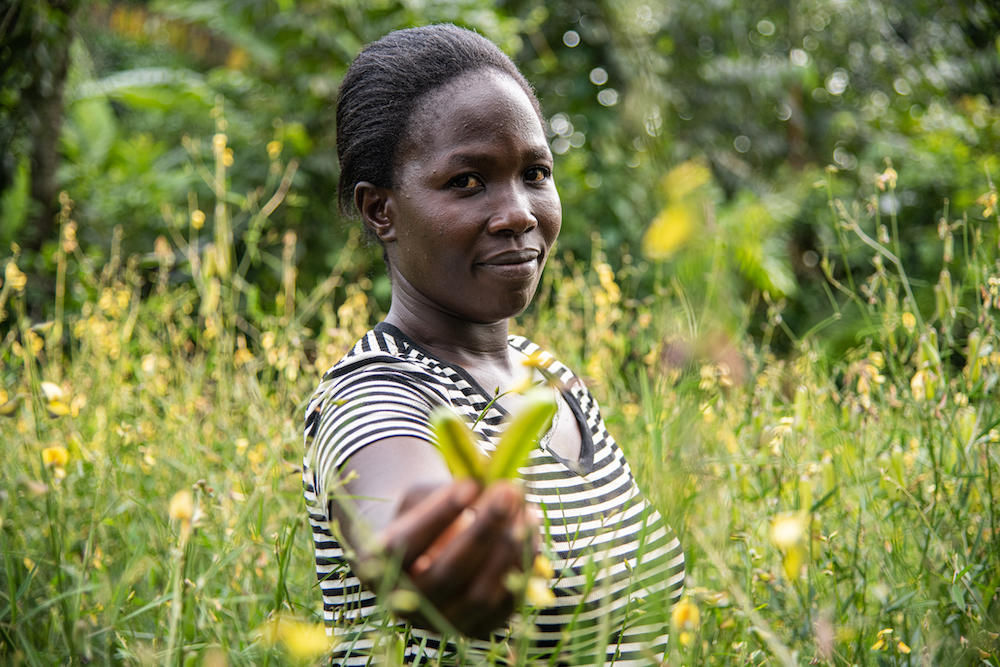From the Field Banking on indigenous seed: investing in a healthier future

Vihiga, Kenya: researchers and farmers have established a community seedbank to cultivate traditional crops that can improve both health and livelihoods.
Evans Ochuto surveys the bright pink plume of the unusual crop on his farm. Next to a giant pumpkin and some healthy-looking green vegetable leaves, the crop, he explains, is the indigenous food Amaranth. Researchers have found that African leafy vegetables contain a wealth of vitamins and minerals. Amaranth for example, contains 200 times more vitamin A and 10 times the iron in the same portion of cabbage.
Since 2014, Ochuto has boosted his income from around US$30 to US$180 monthly, by selling indigenous vegetables and their seeds. “I rely on farming, I grow traditional leafy vegetables like Amaranth, Black Nightshade, Spider Plant, Ethiopian Kale, Pumpkin,” he explains. “I sell the vegetables and seeds to market vendors, relatives, neighbors – the entire community, so they are in high demand,” he says.
Researchers at the Alliance of Bioversity International and the International Center for Tropical Agriculture (CIAT), as well as funders Biovision Foundation Switzerland and the Agriculture for Nutrition and health CGIAR Research Program A4NH and local government, have found that cultivating diverse indigenous crops and seeds can help communities tackle undernutrition, obesity, zinc, iron and vitamin A deficiencies, and boost incomes.

Evans Ochuto shows the diverse seeds and Amaranth he is growing on his farm. ©Alliance/Georgina Smith
More vitamins, more benefits
Nutritionist Lillian Aluso, an Alliance researcher who has worked with communities to build and manage the Vihiga community seed bank, explains: “Outside the seed bank, the farmers have set up a demonstration plot, to show different species and varieties of indigenous leafy green vegetables and promote on-farm diversity in the community.”
Ochuto and a group of farmers in Vihiga, Western Kenya, are among the first to manage their own community seed bank, storing and preserving a wide range of species and varieties of indigenous vegetable seeds with the help of the research teams.
In partnership with Vihiga County Department of Health, through trainings, demonstration plots, seed banks and use of community health volunteers to carry out door-to-door nutrition training, the project has now also reached 14,792 women of reproductive age between the age of 15 and 49 years, in ten sub-locations in the county.
An additional 2,000 non-beneficiary farmers have been trained in kitchen gardening, strengthening food and nutrition security by bringing nutrient-rich neglected indigenous vegetables including Amaranth, Black Nightshade, Spider Plant and Ethiopian Kale back onto the table. Twenty five farmers have been trained in seed multiplication and community seed bank stocking through local partner Seed Savers Network.

Researcher Lillian Aluso at the seed bank in Vihiga, Kenya. ©Alliance/Georgina Smith
“Dietary diversity is key in ensuring the community is healthy,” explains Aluso. “It starts from the farm. If we talk about dietary diversity, we need to go back to where food comes from, and that’s why we encourage farmers to diversify on their farms, to ensure more nutritious meals for their families, especially for children under five and women of reproductive age. It’s also a place of learning, where farmers can identify varieties.”
Investing in what you know
On a lush farm surrounded by ripe pumpkins and vegetables of all colors, Aluso warmly greets Elizabeth Omusiele, a farmer who learned about indigenous vegetable growing from demonstrations at the seed bank. By building plant beds in tiers, she has also learned how to increase productivity in a limited space, reducing moisture loss, especially important during the dry season. “I only knew Kale and legumes, but then with training I started looking for a variety of seeds,” she explains.

Diverse seeds shown by Pauline Odera, a farmer who also runs the seed bank at Vihiga set up together with the Alliance and partners. ©Alliance/Georgina Smith
“When you go to the market, you are not always sure of the species or variety of seeds and you only notice when you have already planted,” she says, adding that finding quality seed is not guaranteed. “The seed bank is a solution. I place my seeds in the bank; other farmers can grow and plant it, knowing exactly what they will harvest. Friends, neighbors or other farmers can also borrow seeds that we have multiplied.”
Concepta Makokha, another farmer who manages the community seed bank at Vihiga, added: “We are preserving these seeds so that our children and the community can get back to traditional foods that our ancestors ate. We are advocating for everyone to go back to the traditional vegetables; to come and get seeds from our seed bank to plant on their farms so they can have vegetables to eat, sell and multiply for subsequent seasons.”
Esther Odera, a nutritionist in charge of community nutrition at Vihiga County Ministry of Health, said: “The community health volunteers and mother-to-mother groups are empowered with nutrition knowledge by research and county experts on promotion and use of indigenous vegetables. They, in turn, reach out to other members of the community. I strongly recommend the project to be expanded as a program for improving health and nutrition among the people of Vihiga.”
Video
Filmed and edited by Georgina Smith
